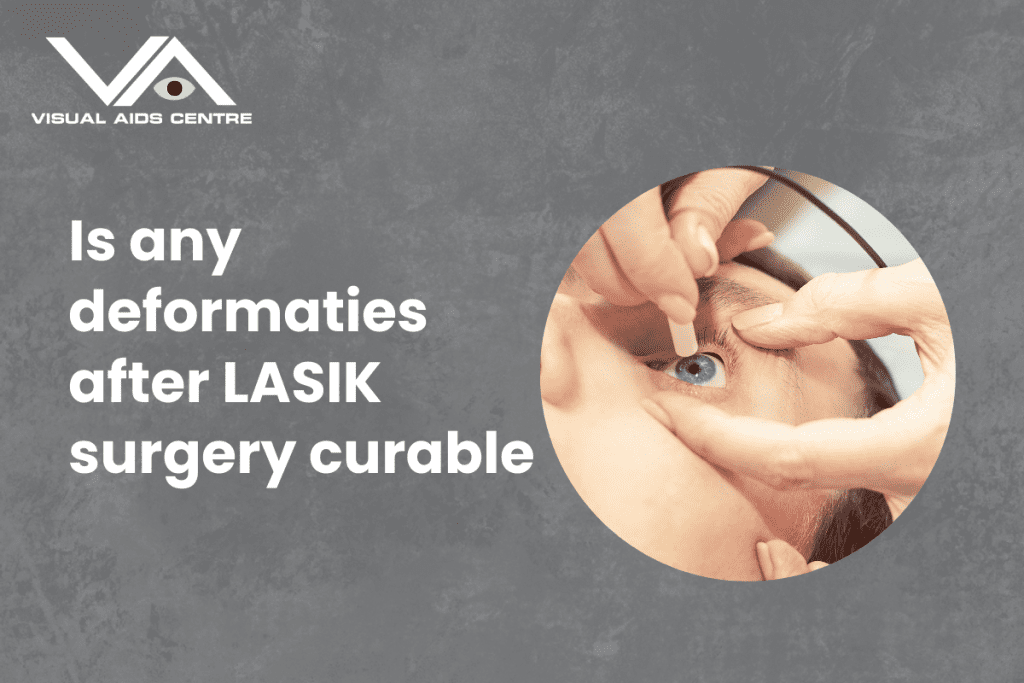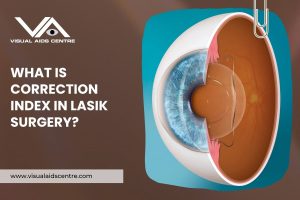Table of Contents
ToggleYes, most deformities or complications following LASIK surgery can be managed or corrected with timely interventions.
With advancements in medical technology and post-operative care, many patients experiencing issues can regain their vision quality and comfort.
LASIK surgery has become one of the most sought-after procedures for vision correction, offering millions of individuals around the globe the freedom to see clearly without glasses or contact lenses. However, like any surgical procedure, LASIK has a small risk of complications or deformities. These rare occurrences often lead patients to ask, “Can these deformities be fixed?” Here, we will explore the most common post-LASIK complications and their curability.

Understanding LASIK and Its Potential Complications
LASIK (Laser-Assisted in Situ Keratomileusis) is a refractive surgery performed to correct vision issues such as nearsightedness, farsightedness, and astigmatism. Although the surgery is widely regarded as safe and effective, certain deformities or complications can arise during or after the procedure. Some post-operative issues may include dry eyes, glare, halos, starbursts, undercorrection, overcorrection, and corneal ectasia.
It is important to understand that while some complications resolve on their own with time, others may require additional treatments or procedures.
Common LASIK Complications and Their Curability
1. Dry Eyes
Dry eyes are one of the most common issues after LASIK, affecting up to 30–50% of patients. The condition occurs because the surgery temporarily disrupts the nerves in the cornea, leading to reduced tear production.
Curability: Dry eyes are typically manageable with treatments:
- Artificial tears or lubricating eye drops.
- Prescription medications like cyclosporine (Restasis) or lifitegrast (Xiidra) to boost tear production.
- Temporary punctal plugs to block tear drainage and retain moisture in the eyes.
- Omega-3 fatty acid supplements or dietary changes to support tear production.
Most people find relief within a few weeks or months, but persistent cases may necessitate long-term management.
2. Glare, Halos, and Starbursts
Some patients experience visual distortions like glare, halos, or starbursts, particularly at night. These issues are often caused by irregularities in the corneal surface shape after surgery.
Curability:
- Mild cases often resolve on their own within 3–6 months as the eye heals fully.
- Customised eye drops can help reduce night glare.
- Wavefront-guided LASIK enhancements or retreatments may improve corneal irregularities and reduce visual distortions in more severe cases.
3. Undercorrection or Overcorrection
Undercorrection (when the desired prescription is not fully achieved) or overcorrection (exceeding the intended correction) can occasionally occur, leaving patients frustrated with suboptimal vision.
Curability:
Both conditions are fixable:
- Additional LASIK touch-ups or enhancements can fine-tune vision correction once the eyes have stabilised (typically 3–6 months after the initial procedure).
- Glasses or contact lenses may serve as a temporary solution until enhancement surgery is performed.
4. Corneal Ectasia
Corneal ectasia is a rare but serious complication in which the cornea progressively weakens and thins. This condition often resembles keratoconus and may result in distorted vision.
Curability: While corneal ectasia is not completely reversible, modern treatments can control its progression and improve vision:
- Corneal cross-linking (CXL): A procedure that strengthens the cornea by creating new collagen bonds.
- Specialised contact lenses, such as scleral lenses, provide clearer vision by creating a smoother refractive surface.
- Corneal transplants may be required in advanced cases, though they are rare.
5. Infection or Flap Complications
LASIK involves creating a corneal flap, and in rare cases, complications like infection or improper healing of the flap can occur.
Curability: These issues often resolve with timely intervention:
- Antibiotic or anti-inflammatory eye drops effectively treat infections.
- Flap repositioning or smoothing performed by the surgeon can correct misalignment.
6. Residual Astigmatism
Astigmatism is caused by an irregularly shaped cornea, and residual astigmatism may persist post-surgery if not adequately corrected.
Curability:
- Enhancements using LASIK or PRK (Photorefractive Keratectomy) can address residual astigmatism.
- Prescription glasses or contact lenses can also help in less severe cases.
7. Regression
Regression occurs when the corneal reshaping achieved through LASIK begins to lose its effect over time, and vision returns to pre-surgery levels.
Curability:
- Enhancement procedures, similar to the initial LASIK surgery, can restore the intended correction.
- Regular follow-ups with your surgeon can monitor and address any regression promptly.
How to Mitigate Potential Issues?
While most LASIK complications are curable, prevention and proper post-operative care can significantly reduce the likelihood of issues.
Tips for Minimising Risks:
- Choose the Right Surgeon: Select a highly experienced and qualified LASIK surgeon who uses advanced technology.
- Thorough Pre-Surgery Evaluation: Ensure you undergo a detailed evaluation to determine whether you are a good candidate for LASIK (e.g., stable prescription, sufficient corneal thickness).
- Adhere to Post-Operative Care Instructions: Carefully follow your doctor’s guidelines for eye care after surgery, including using prescribed eye drops and attending follow-up appointments.
- Avoid Rubbing Your Eyes: This helps prevent flap-related issues or infections.
- Monitor Symptoms: Report any persistent discomfort, pain, or changes in vision to your eye doctor immediately.
Staying Proactive
The success of LASIK surgery depends not only on the procedure itself but also on how well patients adhere to pre-and post-operative care. Regular communication with your ophthalmologist ensures any irregularities are identified and managed promptly.
Advancements and the Future of LASIK
The field of vision correction has come a long way, and ongoing advancements in technology are continually improving the safety and outcomes of LASIK procedures. Here’s what the future holds:
- Wavefront-guided LASIK: Offers more precise corrections tailored to the individual’s unique eye structure.
- Femtosecond Laser Technology: Minimises flap complications by eliminating the use of blades.
- Artificial Intelligence in Surgery: AI-assisted technology can provide enhanced precision and customisation during procedures.
These innovations ensure that even severe complications can be corrected, giving patients confidence in the curability of post-LASIK deformities.
Final Thoughts
LASIK surgery is a proven, safe, and effective way to correct vision, with high satisfaction rates among patients. However, complications or deformities, though rare, can occur. The good news is that nearly all post-LASIK issues are manageable or curable with timely medical attention and modern treatments.
If you’re considering LASIK or are experiencing any post-operative concerns, consult your eye care professional without hesitation. Expert guidance and treatment can help you achieve and maintain the clear vision you deserve.













